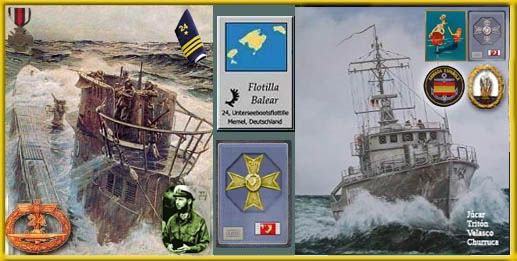
Fotos de la 24F Geweih. Archivo Historico.
Moderador: MODERACION
-
CHARLY1989
- Oberleutnant zur See

- Mensajes: 4535
- Registrado: 30 Sep 2000 02:00
- Ubicación: madrid
- Contactar:
Re: Fotos de la 24F Geweih. Archivo Historico.

"Nos vemos en alta Mar"
Re: Fotos de la 24F Geweih. Archivo Historico.
Lo siento NAZA, repetí el U143...veo que leemos lo mismo 

-
kummetz1938
- Korvettenkapitän

- Mensajes: 7765
- Registrado: 18 Jun 2006 02:00
- Ubicación: Palma de Mallorca
Re: Fotos de la 24F Geweih. Archivo Historico.
El U 29 es el de Otto Schuhart y G.LassenSiurell escribió:
U28, 29, 30

________________________________________________________________
Si hago una buena obra, me siento bien; y si obro mal, me encuentro mal: Esta es
mi religión. (A.Lincoln)...¡Vivir y dejar vivir: Esta es mi política!
Re: Fotos de la 24F Geweih. Archivo Historico.
¿¿Que le pasa a estos dos sub???
¿¿Por que estan tirado en esas plataformas.. desguazados???
!!!!!Punto para el caballero¡¡¡¡
Visite.......http://www.24flotilla.com/ODSH/web.html .... es gratis..
-
CHARLY1989
- Oberleutnant zur See

- Mensajes: 4535
- Registrado: 30 Sep 2000 02:00
- Ubicación: madrid
- Contactar:
Re: Fotos de la 24F Geweih. Archivo Historico.
Pues no lo se,posiblemente sea al final de la guerra...

"Nos vemos en alta Mar"
Re: Fotos de la 24F Geweih. Archivo Historico.
Veamos, dos grupos de submarinos del tipo II (U-9, U-W y el U-24 y posteriormnete elU-19, U-20 y el U-23) fueron transportados hasta su base en Constanza...por via fluvial a traves del Danubio. Esa foto es de su periplo hasta el mar Negro desde el Elba (unas 250 millas).
Saludos.
Saludos.
Re: Fotos de la 24F Geweih. Archivo Historico.
When, in the fall of 1941, it became clear that the war against the USSR would not be a Blitzkrieg, but that a long war must be expected, the German’s high command decided in December 1941 it was a matter of highest priority to transfer submarines to the Black Sea. A seemingly daunting task, much of the trek would require imaginative methods of sea and overland transportation. According to this project, the submarines had to be at first partially disassembled in Kiel and then loaded on shallow-draft pontoons. These were to be towed via the North Sea - Baltic Canal to Hamburg, and then on the Elbe to Dresden. There the submarines were to be shifted from the pontoons to low-bed motorized trailers. Then a drive of 300-mi over highways to Ingolstadt on the Danube was to follow. There the submarines were again to be shifted on pontoons and towed by tugs to Linz or the Romanian Galatz, where they would finally be re-assembled.
To carry out this unique project, a team of 600 men comprising shipbuilders, truck drivers, traffic policemen and other specialists was organized. The transport and auxiliary vehicles comprised heavy towing trucks, multi-axle low-bed trailers with a load-carrying capacity of 60-tons, a great number of trucks, tank trucks for fuel, communication vehicles, truck-mounted workshops and others.
The six Type IIB submarines to be transferred to the Black Sea would form the 30th U-boat flotilla with two groups. The first group comprised U-9, *U-W and U-24 and the second group - U-18, U-20 and U-23.
The preparations for the transfer of the submarines began in the spring of 1942. Because of the limited depth of the waterways, all heavy equipment such as diesel engines, power batteries, guns and torpedoes, were removed. In order to reduce the height, the conning towers were partly dismantled. Once in the dry dock, five pairs of pontoons were fastened side by side vertically on the side of each submarine (the size of each pontoon was 10-ft by 4.5-ft). After filling the dock with water, the submarine with the pontoons was overturned at 90-degrees so that its hull was lying on the ten pontoons, the draft being 4-ft. In this most unusual manner the submarines were transported over water.
For the road transport, each low-bed trailer was towed by two or four towing trucks, which were arranged in tandem, or in pairs in two rows. Driving under and over bridges was most diflicult, requiring high precision and strict attention of the drivers. All bridges were examined in advance and, if necessary, they were reinforced or reconstructed. The distance of 280-mi from the Elbe to the Danube was passed in 56-hrs at a speed of about 5-mph. The change of drivers and the refueling of the towing trucks were carried out without stopping the convoys.
The submarines of the first group were assembled in 42- to 45-days in Linz, and the boats of the second group in Galatz. They were then towed to Sulina in the Danube delta and from there they continued to the Black Sea and their base at Constantsa.
The duration of the transfer of the submarines from the preparation in Kiel to reaching the Black Sea had been ten months. The last boat of the 30th flotilla ( U-20) reached Constantsa in July 1943.
The last boat of the 30th flotilla ( U-20) reached Constantsa in July 1943.
The submarines eventually took part in 57 military missions and in the process sank the following Soviet ships: U-20-tank ship Vaillant Couture (16 January 1944), cargo ship PesteK19 June 1944); U-23- schooner Tanais (23 October 1943), harbor tug Smely (29 May 1944); U-24 - tank ship Emba (30 June 1943).
To carry out this unique project, a team of 600 men comprising shipbuilders, truck drivers, traffic policemen and other specialists was organized. The transport and auxiliary vehicles comprised heavy towing trucks, multi-axle low-bed trailers with a load-carrying capacity of 60-tons, a great number of trucks, tank trucks for fuel, communication vehicles, truck-mounted workshops and others.
The six Type IIB submarines to be transferred to the Black Sea would form the 30th U-boat flotilla with two groups. The first group comprised U-9, *U-W and U-24 and the second group - U-18, U-20 and U-23.
The preparations for the transfer of the submarines began in the spring of 1942. Because of the limited depth of the waterways, all heavy equipment such as diesel engines, power batteries, guns and torpedoes, were removed. In order to reduce the height, the conning towers were partly dismantled. Once in the dry dock, five pairs of pontoons were fastened side by side vertically on the side of each submarine (the size of each pontoon was 10-ft by 4.5-ft). After filling the dock with water, the submarine with the pontoons was overturned at 90-degrees so that its hull was lying on the ten pontoons, the draft being 4-ft. In this most unusual manner the submarines were transported over water.
For the road transport, each low-bed trailer was towed by two or four towing trucks, which were arranged in tandem, or in pairs in two rows. Driving under and over bridges was most diflicult, requiring high precision and strict attention of the drivers. All bridges were examined in advance and, if necessary, they were reinforced or reconstructed. The distance of 280-mi from the Elbe to the Danube was passed in 56-hrs at a speed of about 5-mph. The change of drivers and the refueling of the towing trucks were carried out without stopping the convoys.
The submarines of the first group were assembled in 42- to 45-days in Linz, and the boats of the second group in Galatz. They were then towed to Sulina in the Danube delta and from there they continued to the Black Sea and their base at Constantsa.
The duration of the transfer of the submarines from the preparation in Kiel to reaching the Black Sea had been ten months.
The submarines eventually took part in 57 military missions and in the process sank the following Soviet ships: U-20-tank ship Vaillant Couture (16 January 1944), cargo ship PesteK19 June 1944); U-23- schooner Tanais (23 October 1943), harbor tug Smely (29 May 1944); U-24 - tank ship Emba (30 June 1943).
Re: Fotos de la 24F Geweih. Archivo Historico.
Serás c....  Debí imaginarmelo
Debí imaginarmelo 
Re: Fotos de la 24F Geweih. Archivo Historico.
Saludos:
Aporto mi granito de arena con una foto del U-101 regresando a puerto

otra sacada en alta mar

Aporto mi granito de arena con una foto del U-101 regresando a puerto

otra sacada en alta mar

•Nada en el mundo es más peligroso que la ignorancia sincera y la estupidez concienzuda (Martin Luther King).
-
CHARLY1989
- Oberleutnant zur See

- Mensajes: 4535
- Registrado: 30 Sep 2000 02:00
- Ubicación: madrid
- Contactar:
Re: Fotos de la 24F Geweih. Archivo Historico.
El U-8...


El U 8 (IIB) de viaje hacia Königsberg, 1937 (foto Karl Daublebsky von Eichhain
SACADO: coleccion S.MATA...


El U 8 (IIB) de viaje hacia Königsberg, 1937 (foto Karl Daublebsky von Eichhain
SACADO: coleccion S.MATA...
Última edición por CHARLY1989 el 04 Jun 2009 20:45, editado 1 vez en total.

"Nos vemos en alta Mar"
-
CHARLY1989
- Oberleutnant zur See

- Mensajes: 4535
- Registrado: 30 Sep 2000 02:00
- Ubicación: madrid
- Contactar:
Re: Fotos de la 24F Geweih. Archivo Historico.
El U-9...

El U 9 (IIB) emerge en el Báltico (foto Karl Daublebsky von Eichhain
Sacado: coleccion S. MATA...

El U 9 (IIB) emerge en el Báltico (foto Karl Daublebsky von Eichhain
Sacado: coleccion S. MATA...
Última edición por CHARLY1989 el 04 Jun 2009 20:47, editado 1 vez en total.

"Nos vemos en alta Mar"
-
CHARLY1989
- Oberleutnant zur See

- Mensajes: 4535
- Registrado: 30 Sep 2000 02:00
- Ubicación: madrid
- Contactar:
Re: Fotos de la 24F Geweih. Archivo Historico.
U-71...

Adornando con flores la torreta del U 71 tras su llegada a la base de St. Nazaire en la segunda mitad de 1942. Su comandante, el vienés Hardo Rodler von Roithberg, habla por el megáfono (foto Carl-Gabriel von Gudenus).

La tripulación de un U-Boot (U 71) recibe correspondencia a su llegada a un refugio francés: en enero de 1943 tuvo lugar el primer bombardeo aliado —infructuoso— de uno de estos búnkeres (foto Carl-Gabriel von Gudenus.

El comandante del U 71, Walter Flachsenberg, es un ejemplo de la tolerancia que reinaba en cuanto a uniformidad en los U-Boote: antirreglametario es no sólo el habitual emblema del U-Boot en la gorra (en este caso, una serpiente o dragón marino), sino también el abrigo de piel (foto Carl-Gabriel von Gudenus
sacado:coleccion S MATA...

Adornando con flores la torreta del U 71 tras su llegada a la base de St. Nazaire en la segunda mitad de 1942. Su comandante, el vienés Hardo Rodler von Roithberg, habla por el megáfono (foto Carl-Gabriel von Gudenus).

La tripulación de un U-Boot (U 71) recibe correspondencia a su llegada a un refugio francés: en enero de 1943 tuvo lugar el primer bombardeo aliado —infructuoso— de uno de estos búnkeres (foto Carl-Gabriel von Gudenus.

El comandante del U 71, Walter Flachsenberg, es un ejemplo de la tolerancia que reinaba en cuanto a uniformidad en los U-Boote: antirreglametario es no sólo el habitual emblema del U-Boot en la gorra (en este caso, una serpiente o dragón marino), sino también el abrigo de piel (foto Carl-Gabriel von Gudenus
sacado:coleccion S MATA...

"Nos vemos en alta Mar"
-
CHARLY1989
- Oberleutnant zur See

- Mensajes: 4535
- Registrado: 30 Sep 2000 02:00
- Ubicación: madrid
- Contactar:
Re: Fotos de la 24F Geweih. Archivo Historico.

Imagen de los preparativos del traslado de los submarinos.
Es interesante comentar la historia de los sumergibles U-19, U-20 y U-23. Formaban parte de la 30ª Flotilla alemana (compuesta por seis submarinos) que fueron trasladados 2000 millas por tierra (desmontados parcialmente y transportados en camiones) y algún tramo por el Elba, desde el puerto alemán de Kiel en el Báltico al rumano de Constanza, en el Mar Negro. En 1941 Alemania invadió Rusia y se pensó que era necesaria su presencia en el Mar Negro para hostigar a los mercantes soviéticos. En dos años lograron su objetivo, la flota hundió decenas de buques y perdió tres de sus unidades por acciones del enemigo.

"Nos vemos en alta Mar"







